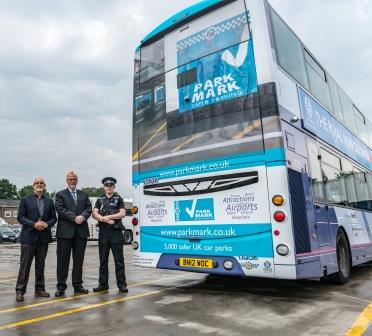Norwich city launches the Art of Safer Parking campaign
The campaign brings into focus the elements usually taken for granted but essential to ensuring car parks are kept to a high standard. The hidden elements such as cleaning, lighting, design and the environment brings people behind the scenes into the foreground in a subtle way.
Peter Gravells, area manager for the British Parking Association who manage the scheme on behalf of the police said: “People want an environment that looks pleasant and has plenty of light. Car parks are just a functional space that people don’t spend much time in, but if in poor condition it is likely people won’t want to use it at all. Well maintained car parks in good condition often go unnoticed as our expectations are being met. The campaign illustrates the work that goes on behind the scenes to prevent crime and the fear of crime in car parks.”
Research undertaken by the British Parking Association has shown that people place personal safety alongside destination as top priorities when choosing somewhere to park, followed by a safe environment. The campaign focuses on the safer parking scheme criteria that are known to reduce crime and the fear of crime in car parks and aims to bring the scheme’s brand into people’s consciousness so that they know what to look for. The bus in Norwich features the Park Mark logo used as a backdrop to show that the scheme is for, and about people as much as it is about cars.
Three models are painted from head to toe by body-painting artist Carolyn Roper after which, photographer Andrew Wilkinson took the final pictures. ‘This campaign is the first time I’ve done a photoshoot in a car park. I wasn’t sure what to expect,’ said Wilkinson. ‘I suppose, as a member of the public, you assume they are all the same, but that’s not the case. As a photographer, you realise how different they can be – in terms of light and design, for example.’
Asked if he found car parks beautiful Andrew laughs: “Traditionally, they’re not thought of as beautiful places – form follows function, of course, and these are functional structures. But I’ve noticed, in recent decades, that there is an increasing focus on their architectural forms – the way that they’re clad, their shapes, they’re brighter inside. From the grotty car parks of the past, things really have changed.’
Artist Carolyn Roper, who has worked on everything from ad campaigns and music videos to a Hollywood movie, talked about the techniques being used. ‘It shows how people can just disappear, you don’t see them doing really important jobs,’ she said. ‘I think this is a great way of drawing attention to something that people normally wouldn’t pay much attention to. The public don’t really think about what goes into making a car park safe, and it would probably be a hard subject to make them interested in. That’s where body painting is so useful; it makes people want to look – it has that head-turning effect – and can really highlight the work and the effort that goes into making car parks a safer place to be.’
A behind-the-scenes, time-lapse video that shows the models being painted for the photoshoot can be viewed the Park Mark Facebook page and website.
Norfolk Constabulary was keen to promote the Safer Parking Scheme across the county, and the bus was seen as a good way to do this.
“Having a bus driving across the Norwich area will provide a great opportunity to promote the benefits of Park Mark further and whilst the public actively ‘look out’ for the bus, perhaps consider the very real safety assurance Park Mark gives them“, says Dick Wolsey, one of the police Architectural Liaison Officers responsible for assessing Norfolk’s Park Mark car parks.
“We have 52 Park Mark accredited car parks in Norfolk and 28 of those are in Norwich. Not only did we want to shout about that but we want the many welcome visitors to Norfolk to know they truly made a safe and secure choice.”
Crime prevention is an efficient use of resources and as vehicle related crime in car parks costs the economy around a billion pounds a year in England and Wales, it is the aim of the BPA and Police Crime Prevention that the scheme continues to grow. At present there are around 5,000 Park Mark car parks in the UK out of an estimated 20,000 in total.
Photo: (left to right) Dick Wolsey, Architectural Liaison Officer Norfolk Constabulary, Peter Gravells, BPA Area Manager and PC Adam Binns, Norfolk Constabulary
- Like
- Opslaan








